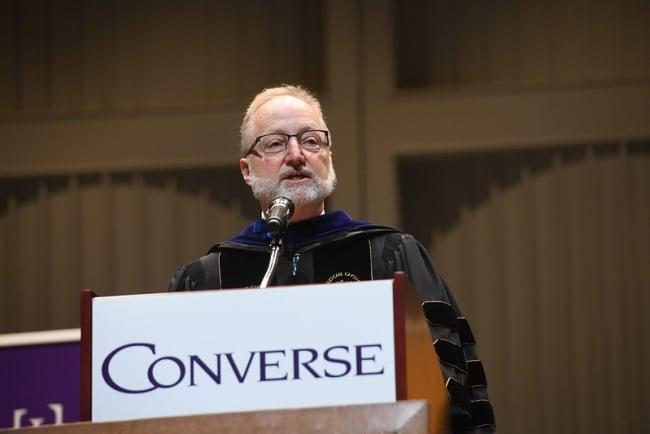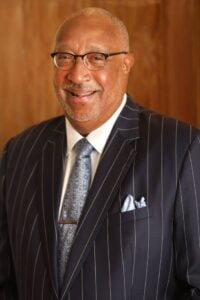You have /5 articles left.
Sign up for a free account or log in.

Jeffrey Barker had been provost at Converse University for two decades before becoming interim president.
Courtesy of Converse University
Jeffrey Barker and Irving McPhail were both new presidents whose tenures were cut short by tragedy.
Barker, president of Converse University in Spartanburg, S.C., died in a bicycle accident in July, less than three weeks into his presidency. McPhail, who served as president of Saint Augustine’s University in Raleigh, N.C., for just three months, died after contracting COVID-19 last October.
Overnight, their universities were left without a leader, and their governing boards worked quickly to chart a path forward. A handful of institutions -- including North Georgia Technical College and St. Bonaventure University -- have lost presidents to COVID-19 in the past year, throwing well-planned leadership transitions into disarray and creating management challenges at a time when the colleges were already burdened with the pandemic.
The deaths have become unfortunate but instructive models in the pandemic era for how to manage an institution after the sudden death of its leader.
“There has been a lot of talk about succession planning over the years, but this really brought it close to home for many colleges or universities, because they were faced with having to replace the president during a pandemic,” said Rod McDavis, managing principal at AGB Search, the executive search arm of the Association of Governing Boards of Universities and Colleges.
Quite a few presidents have resigned or retired during the pandemic, so succession plans have become a top-of-the-agenda item for boards, McDavis said.
Converse was just beginning a search process for a permanent president when Barker postponed his retirement to step into the interim role. After serving as provost for six years, Barker had the expertise to lead the university, said Sandra Shearouse Morelli, chair of the Converse University Board of Trustees.
“It didn’t take us more than about a nanosecond to recognize that we had a very, very capable person sitting in the provost seat,” Morelli said. “He was the right person at the right time.”
Barker was not in the running to become Converse’s permanent leader, but he had big ideas for the university for his one-year interim term, Morelli said. He planned to improve academic programs and student life, increase enrollment and retention, maintain fundraising momentum, and improve diversity and inclusion at the university.
The Board of Trustees held an emergency executive session the morning after Barker’s death to appoint another interim president. The trustees chose Boone Hopkins, who at the time was interim provost and whose selection met the terms of an existing presidential succession clause in the board's bylaws.
“The personal challenge of losing a dear friend and trusted mentor was heartbreaking for me,” Hopkins said in an email. “However, I have taken great comfort in the phenomenal support I have received from our executive leadership team and the entire Converse community. A tragedy like this reveals the power of our bonds and at Converse we all realized quickly that Dr. Barker’s model of collaborative leadership had prepared us well to move forward together, especially in difficult moments like this.”
Converse had a deep bench of talented leaders to choose from, Morelli said. The board plans to review its succession procedures and look for areas of improvement should the university face another sudden transition in the future.
The approach the Converse board took is exactly right, according to Merrill Schwartz, senior vice president for content strategy and development at AGB. Schwartz recommends that college and university governing boards have a clear emergency succession plan like the one outlined in Converse’s bylaws. The association suggests including a presidential succession clause as part of the provost’s job description.
“Anything can happen in a presidency,” Schwartz said. “It’s important for the institution to know that we have a plan for immediately continuing to operate smoothly and that the essential responsibilities of the president will be carried on by a designated officer of the institution.”
Without such a plan, an institution can be left scrambling to find a leader, McDavis said. This chaos could have an impact on fundraising efforts and lower employee morale at an institution.
While Barker’s absence won’t affect the ongoing search process for a permanent president, “His wisdom is going to be missed,” said Wallace Davison Prestwood, vice chair of the Board of Trustees.
St. Bonaventure also appointed its provost, Joseph Zimmer, to serve as acting president when former president Dennis R. DePerro died in March.
“Words simply can’t convey the level of devastation our campus community feels right now,” Zimmer said in a March statement. “I know when people die it’s become cliché to say things like, ‘He was a great leader, but an even better human being,’ and yet, that’s the absolute truth with Dennis. We are heartbroken.”
North Georgia Technical College chose another top administrator -- Vice President of Administrative Services Michele Shirley -- to fill the interim president role after former president Mark Ivester died in September.
“This is truly an honor to help lead North Georgia Technical College and continue fulfilling the college goals and visions that Dr. Ivester had set forth,” Shirley said in a statement at the time. “We have a wonderful, supportive college community, and we are all thankful for the outpouring of love shown for Dr. Ivester and his family.”
Saint Augustine’s officials took a different approach when they lost their new president after only three months. Instead of promoting a top administrator to the interim presidency, the university tapped McPhail’s widow.
 “They felt that because my husband and I were partners, that I would be familiar with the directions that they had agreed to take the university,” said Christine Johnson McPhail, the new president of Saint Augustine’s. “Of course I was, because he had shared his plans and hopes and dreams for the university with me.”
“They felt that because my husband and I were partners, that I would be familiar with the directions that they had agreed to take the university,” said Christine Johnson McPhail, the new president of Saint Augustine’s. “Of course I was, because he had shared his plans and hopes and dreams for the university with me.”
Christine McPhail will serve as president of Saint Augustine’s for at least four years. Prior to taking the helm, she served as president of Cypress College in California and was founding director of Morgan State University’s community college leadership doctoral program.
Because of her familiarity with Saint Augustine’s and higher education more generally, the board did not have to sell the faculty on her appointment, Christine McPhail said.
“My transition here wasn’t ‘OK, here’s a new person coming in,’ but rather ‘Here’s a person that believes what we believe,’” she said.
She plans to see through her late husband’s vision for the historically Black university, which includes improving student training experiences, upgrading campus infrastructure and addressing inequities in state and federal funding for HBCUs.
Both Saint Augustine’s and Converse experienced relatively smooth leadership transitions even during a period of grief on campus. The two boards’ actions serve as good examples for other institutions that find themselves in similar situations, Schwartz said.
“It’s good for boards to use these learning opportunities so that they can be prepared should something happen at their institution,” she said.




